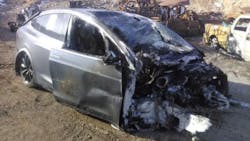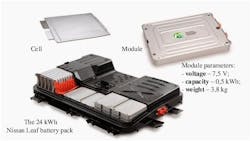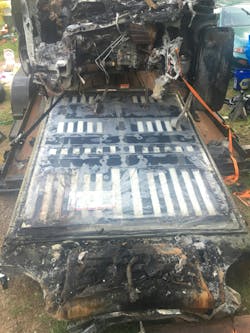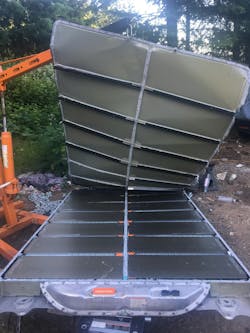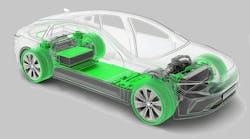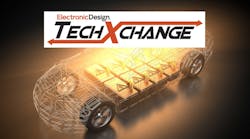Electric-Vehicle BMS Design Impacts Second-Life Value Proposition
Look at just about any discussion of an electric vehicle’s (EV) battery lifetime and there’s alleged handwringing over statutory warranty periods, cost of replacement, and industry capacity to recycle the valued materials. Most of the “concerns” are coming from anti-EV “environmentalists,” though.
“Federal law requires automakers to warranty EV and hybrid batteries for at least eight years or 100,000 miles. California requires a 10-year, 150,000-mile warranty on EV and hybrid batteries.”—Caredge.com
Despite the efforts of legislators to create consumer confidence, the iPhone Dunning-Kruger-effect crowd spreads misinformation on social media, by experiential extension, about EV batteries lasting only three or four years before needing replacement. It doesn’t. The key to the longevity differences isn’t in chemistry, but in the way the batteries are managed—by a battery-management system (BMS).
BMS Monitoring and Control
An automotive BMS manages groups of paralleled cells by monitoring voltage and temperature, and it controls charge rate, cell balancing, discharge rates, and battery temperature.
In most automotive applications, thermal management, i.e. battery temperature, by the BMS is done through control of liquid-cooling systems that include pumps, heat exchangers, as well as battery heaters and chillers. The objective of the BMS is to minimize the temperature spread across the cells, which directly results in chemical-reaction rates in the battery’s cells being more or less matched.
Similarly, the BMS monitors the voltage across groups of paralleled cells, to ensure minimal voltage variation in the series string of those groups that comprise the battery. Doing so attempts to maximize the amount of energy each cell group can store. It also attempts to equalize the depth of discharge, since the first cell group to discharge to its minimum allowable voltage results in a fully depleted battery, despite other cells possibly having energy remaining. In other words, the “weakest cell” group determines the capacity degradation of the entire battery.
The BMS can discharge selected cell groups to lower the voltage to match them within a few millivolts. This process is done by either dissipating the excess energy with a resistor across the cell group, or, more expensively, by moving charge from one cell to another.
The weakest cell group can be a cell that’s cooler than its siblings in the pack. Nissan made a design decision, based on keeping vehicle costs down, to eliminate active (liquid) cooling of the early Leaf’s pack (Fig. 1). Due to the thermal mismatches during charging and discharging of the pack, cells would degrade at different rates, quickly lowering pack capacity to the lowest common denominator cell.
A second-hand Leaf, as a result, is available for very minimal cost, typically with half its range being lost due to accelerated pack degradation. It was a deliberate design decision—not a design flaw that resulted in the largest number of EVs sold up until well after the debut of the Tesla Model 3.
Interestingly, the Leaf used the CHADeMo charging standard, which is very amenable to bidirectional charging. It can take power from the grid as well as deliver power back to it (“V2G” or vehicle-to-grid).
The BMS in an electric vehicle is used to manage the battery for longevity, but its main visibility to vehicle operators is in predicting range—it’s the fuel gauge in an electric vehicle. The BMS also determines the maximum charging rate of the battery, whether the charging occurs from electric-vehicle supply equipment (EVSE), a public charger, or by regeneration of energy from the vehicle’s traction drive system.
They can be sources of frustration for EV operators, who see significantly diminished charge rates during cold weather. The BMS limits charge rate during low temperature operations to prevent cell damage due to lithium plating. The BMS also limits discharge rates at very low temperatures, again observed as a “power reduced” warning on the information screen of the EV. All of this is to extend the life of the battery and provide maximum allowable vehicle performance.
The Push to Extend Battery Life
Inevitably, usually based on number of charge cycles, an EV battery will degrade in its energy capacity to 80% of its infant kWh rating. The battery is still fully functional; it’s just that the maximum voltages are lower, the energy capacity is lower, and a range reduction of the vehicle is reduced to 80% of the range when new. That 250-ish mile Chevy Bolt now has a range of 200 miles, likely at around 250,000 to 300,000 miles.... he’s not dead, Jim.
Recent discoveries have also been made in the way batteries are manufactured, to where lithium battery life can be extended by around 50%. Manufacturing equipment suppliers have the machines ready to facilitate the manufacture of extended life cells without changing chemistry. That Chevy, had it been equipped with the newer formation technology, would still go 200 miles, but with almost a half a million miles on the clock.
Does the battery in the hypothetical half-million-mile Chevy need a ~$13,000 [editor note: last time I checked at my local Chevrolet parts department, $200/kWh] pack replacement? Arguably not.
The 2011 Nissan Leaf, though, had an initial range of 84 miles with its 24-kWh pack. Its quick degradation due to thermal-management choices would result in about 60 miles of range, in warm weather, at a 70% capacity reduction. Thus, it was rendered almost useless in the U.S., where the average commute distance is 41 miles and a large portion of the country sees cold temperatures in winter months. “Scrap” the car? Recycle the battery?
With around 150,000 Leafs produced through 2020, that’s a lot of “toxic lithium going to the landfill,” as the Dunning-Kruger crowd would post on social media out of feigned concerns for extracting more lithium out of the ground.
The reality is that the cars are readily available for around $4,000, with insurance salvage auctions of “totaled” vehicles running at around half that, resulting in battery costs of $150-300/kWh, not counting recovery of funds by selling drive and body components. In the California market, Facebook Marketplace has listings for FREE, battery-stripped, Leafs. Leaf battery modules and packs are available from China as higher-capacity replacements.
Other liquid-cooled EVs with higher state-of-health (SOH) batteries are too expensive to buy as used, functional vehicles. However, insurance auctions of totaled vehicles yield batteries and drive components for between $5,000 (the car, “Burnie,” in the insurance auction in this article’s promo image at the top of this article) and $20,000 for a rebuildable wreck.
A totaled Chevy Bolt is around $10k at insurance auctions, which is about the same as the cost of a used Bolt—counting the cost recovery of drive units, doors, panels, and other components. The battery itself works out to around $100/kWh, which is half the cost of a new pack.
So, here’s one myth to bust: It's not $13k for a new battery pack, but rather $8,000 for one because the used pack has value at 80% SOH (53 kWh). With the market value of between $9,000 and $13,000 for a three- to four-year-old Bolt, thanks to the $4,000 tax credit on used EVs, it’s easy to see how a $6,500 battery pack and $3,000 drivetrain as salvage value can equate to a totaled car with only $3,000 in damage. This means there’s an ample supply of batteries and drivetrains from EVs from the salvage yards and insurance auctions.
With the economics of EV salvage component values, it would be crazy to send functional, >80% SOH batteries through a recycler’s shredder for recovery of strategic materials, including lithium, nickel, copper, aluminum, manganese, cobalt, etc.
This, again, is where the anti-EV crowd gets it wrong in their “environmental” concerns of EV batteries winding up in the landfill or about insufficient recycling capacity for the number of vehicle batteries being produced. Yes, EV cell recycling capacity is needed, but recycling is primarily of yield fallout, infant mortality, cells, and not of “end-of-life” cells extracted from clapped-out, 300,000-mile cars and trucks.
What to Do with 80% SOH EV Packs?
A rational owner would simply keep driving an EV that had an initial range of 250-300 miles. At 80% SOH, the vehicle can still go 200-240 miles on a charge with around 300,000 miles on the odometer. At 70%, that range degrades to 175 to 210 miles. Let’s not forget that the average round-trip commute in the U.S. is 41 miles, so it’s arguable in warmer climes that a 20% SOH EV is still serviceable on average.
But, there’s that once-a-year, 600-mile trip to grandma’s house, which dictates replacing the battery in the daily commuter for $13k...not unreasonable, considering the car can go another 300,000 miles for that minimal outlay.
Hypothetically, there should be a supply of 80% SOH batteries...20 years out from when EVs hit their stride, arguably around 2017-2018 when the Leaf and Model S/X/3 were joined by the Chevy Bolt, Mustang Mach-E, Hyundais, Veedubs, etc. So, apparently, there’ll be a tidal wave of used batteries, thanks to grandma being a peaceful six-hour drive from her offspring, starting at around 2037. Yes, 2037. For the fans of recycling a battery with 53 kWh of storage, we’re still a dozen years away before those recycling plants are needed.
Thus, the primary source of used EV batteries, modules, and cells will be salvaged from totaled vehicles over the next years. The primary source of EV battery components will be salvage companies, though a cottage industry will exist of businesses and individuals buying either used or totaled vehicles and parting them out. Like Burnie (new cars get identified by name in their apps and telematics, so why not?) was for its burnt battery pack (Fig. 2).
Is There a Second Life After Cremation?
“Burnie” was procured on a bet that the pole it hit at extremely high speed, which intruded so far into the car where it took out the front drive unit, busted up the central computer system and its touchscreen display in the passenger cabin, and displaced and compressed the front “penthouse” of battery modules, lighting them off into a fire that consumed the battery penthouse (a stack of two battery modules vs. the planar side-by-each arrangement of the rest of the modules in the pack). It still had functional battery modules in the pack, though.
The bet, however, was hedged by the value of the rear drive units and its two alloy wheels, and of the rear quarter panels and the Falcon Wing doors; a second 8,000-mile Model X, “Spinout,” needed to restore it to being roadworthy. Twelve of Burnie’s 16 modules were unscathed by the fire. Two modules near the front (furthest away in Figure 3) were partially burned (though about half their functional cells could still be extracted), and the two front-stacked “penthouse” modules were burnt to leave little behind but char and burnt metal (Fig. 2, again).
Twelve gorgeous, fully functional battery modules, 5.3-kWh apiece and matched in voltage to within 10 mV or so (the voltage variations are in the Harbor Freight meters, not the battery modules), were extracted (Fig. 4).
These were subsequently sold for ~$160/kWh to a local craftsman who was hand building a large wooden boat with enclosed wheelhouse, from scratch, that was capable of seakeeping. Its propulsion system would be...electric. I doubled the money on the car, still had the quarter panels, Falcon Wing doors for Spinout, rear drive unit, a very-high-capacity onboard HV battery charger, and a pair of fancy schmancy alloy wheels all going back into second life usage in future projects, not the landfill or crusher.
The Meaning of (Second) Life
Second life is all about repurposing and reuse. It creates a circular economy that minimizes energy input and cost to create new things or capability, while enabling the conversion of, and/or displacing, a worse technology or solution to a problem.
One of the second-life applications for EV components, primarily the drive units and HV batteries, is in internal-combustion-engine (ICE) conversions. From classics to clunkers, an EV conversion gives an ICE vehicle a new lease on life, better performance, and cheaper and cleaner operation. Some of the methods the DIY ICE/BEV conversion community are using to convert an ICE to BEV (battery electric vehicle) were covered by this blog on Electronic Design’s site.
The largest second-life application for BEV batteries, currently, is for grid and home solar-energy storage.
Piqued by Peak Demand
Despite residential storage solutions being available from the likes of Tesla and General Motors, the use of repurposed EV batteries, either in grid or residential solar applications, provides an economical method of time-shifting peak-generation/lowest-grid-price to peak demand/highest-grid price periods.
A girl phoned me the other day and said... “Come on over, there's nobody home.” I went over. Nobody was home.—Rodney Dangerfield
For residential solar, ignoring retirees and those fortunate enough to WFH, peak power generation occurs when the members of a household are at work or school; peak demand is in the evenings, and electric cars charge overnight. Such off-grid storage systems have traditionally been implemented with deep-cycle lead-acid batteries, which require maintenance. They also pose an explosion hazard from hydrogen gas during charging. The pricing of these lead batteries set the bar for pricing of second-life BEV batteries, much to the chagrin of the EV ICE/BEV conversion community.
Ad hoc teams of hackers, like those on secondlifestorage.com, have targeted numerous BEV packs for residential energy storage with techniques that include CAN message spoofing/decoding. Most use a Lillygo CAN bus to GEN24 Modbus (RS485) bridge circuit board, translating the BEV battery’s CAN bus information into information that a solar inverter can understand (Fig. 5).
A solution for the EGMP 800-V EV battery platform, as is found in the Kia EV5/6/9, Hyundai Ioniq 5/6, and the Genesis GV60, requires a CAN-FD interface in addition to the Lillygo board. That solution has been shared as open source within the past year.
Though not a comprehensive list, some of the BEV batteries that can be used for residential energy storage, in addition to the EGMP battery platform, include:
For grid storage, second-lifed EV batteries can also time-shift peak solar generation to peak demand periods in the evening. Companies like B2U and Moment Energy are repurposing BEV batteries in shipping containers, claiming a 70% lower cost vs. new grid storage systems such as the Megapack from Tesla.
Unsustainable EV Battery-Pack Design
The second-life applications of EV batteries and modules stems from the dedicated and selfless efforts of individuals providing solutions for being able to control and read battery status via CAN bus. These messages and protocols are undocumented by OEMs. They seem to hold onto the messaging as if it was some kind of trade secret to read a temperature, current, or cell group voltage, to control precharge and contactors, and to balance battery cells.
With 50 states having either enacted or in the process of legislating right-to-repair laws, lawmakers have yet to catch up on the notion that automotive module communications are somehow proprietary.
Advocates of “zonal power,” for example, tout the weight savings in copper cable. However, an undocumented Ethernet or CAN bus messaging to/from the zonal controllers means they go into the trash or get ground up for materials content because there’s no way to repurpose the modules to a second-life application.
Many EV battery modules have “satellite” boards that use galvanic isolation to communicate with a “Master BMS” board in the pack, creating a rat’s nest of sensor or satellite board wiring. The solution? Let’s use RF communications instead. Oops, it can get hacked, so let’s encrypt the links to/from the battery modules.
How is a module going to get repurposed if it uses encryption? It can’t, so the likes of Ultium could end up in the recycler’s shredder vs. being repurposed in second-life applications such as residential energy storage, grid energy storage, or ICE/BEV conversion. The replacement battery is not subsidized by any appreciable amount for its materials content, unlike a battery that’s still fully functional apart from having its maximum energy storage level depleted by 20% to 30%, if even that much is salvaged from a totaled vehicle like Burnie.
There are also wild cell-to-pack packaging schemes where a sea of cells is glued down to a cooling plate, which could still work if the battery pack was controlled by its control connectors, but rebuilding the pack for other form factors, such as is needed in ICE/BEV conversions by rearranging cells or (nonexistent) modules, is impossible. This diminishes the value of the pack at salvage, causing insurance rates to rise.
The ultimate poster child for unsustainable design is cell-to-chassis, where cells are glued into a massive casting in the bowels of the vehicle. With this packaging scheme, residential storage would need to hang the Tesla Model 3 on the garage wall.
It’s the wild west out there right now. A standard form factor for battery modules (an arrangement of series and paralleled cells) isn’t ubiquitous. Messaging for control and sensor readings is either encrypted or undocumented. Lids on battery packs are usually glued on with an adhesive that prevents easy access for repairs, maintenance, and harvesting of internal modules and components. There’s no reason for OEMs not to document CAN messaging for modules in a vehicle, so those modules can be redeployed to second-life applications.
Killing Combustion Off for a Half Century
Worst of all, battery-system design life by OEMs is for 15 years, not the 40+ years an EV battery that’s redeployed to a second-life application will see. A half century, easily, if new formation techniques are used in birthing lithium battery cells, and a couple of centuries if newly announced lithium injection methods are employed.
But nothing compares to the luddites and anti-EV groups who label an EV as an “iPhone on wheels.” That analogy takes down 40 years of energy storage for every EV that doesn’t go out the factory door—energy storage that displaces combustion completely, not only in ICE vehicles, but in methane-burning, "peaker," electric-generating plants.
AndyT's Nonlinearities blog arrives the first and third Monday of every month. To make sure you don't miss the latest edition, new articles, or breaking news coverage, please subscribe to our Electronic Design Today newsletter.
>>Check out this TechXchange for similar articles and videos
About the Author
Andy Turudic
Technology Editor, Electronic Design
Andy Turudic is a Technology Editor for Electronic Design Magazine, primarily covering Analog and Mixed-Signal circuits and devices. He holds a Bachelor's in EE from the University of Windsor (Ontario Canada) and has been involved in electronics, semiconductors, and gearhead stuff, for a bit over a half century.
"AndyT" brings his multidisciplinary engineering experience from companies that include National Semiconductor (now Texas Instruments), Altera (Intel), Agere, Zarlink, TriQuint,(now Qorvo), SW Bell (managing a research team at Bellcore, Bell Labs and Rockwell Science Center), Bell-Northern Research, and Northern Telecom and brings publisher employment experience as a paperboy for The Oshawa Times.
After hours, when he's not working on the latest invention to add to his portfolio of 16 issued US patents, he's lending advice and experience to the electric vehicle conversion community from his mountain lair in the Pacific Northwet[sic].
AndyT's engineering blog, "Nonlinearities," publishes the 1st and 3rd monday of each month. Andy's OpEd may appear at other times, with fair warning given by the Vu meter pic.
